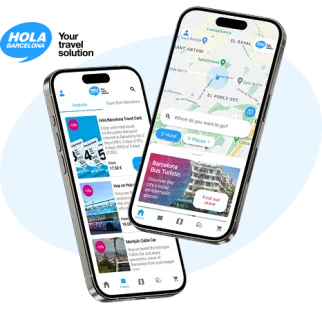Montjuïc Olympic Ring
The main stage of the ’92 Olympic Games
A living memory of the Barcelona ’92 Olympic Games, the so-called Olympic Ring is the group of sports facilities built or renovated for the Games. Some now serve as venues for sporting and musical events; others remain open spaces where locals enjoy sports.

Barcelona Bus Turístic, on the Hola Barcelona app
Your app for visiting the city with the Barcelona Bus Turístic: routes, stops and the most iconic places. A comfortable way to carry your tickets too!
Visit 400 hectares of Olympic spaces transformed into public areas at the heart of Montjuïc
Lluís Companys Olympic Stadium: Host of the opening and closing ceremonies of the Olympic and Paralympic Games of Barcelona ’92, as well as the athletics events. Although the stadium was originally built in 1929, it was completely refurbished for the Games—except for the façade, which remains original. It has a capacity of 60,000 spectators.
Palau Sant Jordi: Constructed especially for the Games by Japanese architect Arata Isozaki, this arena hosted the Olympic events of handball, gymnastics, and volleyball, and the Paralympic events of table tennis and volleyball. Directly in front is the art installation Utsurohi (Change), by Aiko Miyawaki, dedicated to movement and dynamism.
Bernat Picornell Swimming Pools: Inaugurated in 1970, they were renovated to host swimming, synchronized swimming, and water polo competitions during the 1992 Olympics.
Montjuïc Communications Tower: Designed by architect and engineer Santiago Calatrava, who paid homage to Gaudí and Jujol by covering its base with the distinctive trencadís mosaic. The communications tower also functions as a sundial, casting its shadow over Plaça Europa.
INEFC Barcelona: A classically styled building designed by Catalan architect Ricard Bofill for the Olympics, now home to one of the headquarters of the National Institute of Physical Education of Catalonia. It hosted the Olympic wrestling (freestyle and Greco-Roman) events, and during the Paralympic Games, the wheelchair fencing and judo events.
Joan Antoni Samaranch Olympic and Sports Museum: Opened in 2007, this museum includes interactive spaces using advanced technology to showcase the city’s sporting history.
How to get to the Olympic Ring
The Olympic Ring stop on the Red Route of the Barcelona Tourist Bus drops you off right on the avenue of the stadium, giving easy access to the area.
For the curious
- In 1986, Barcelona was designated an Olympic city and began a transformation in terms of construction and infrastructure.
- There’s an Olympic Route—check at the main venues for more information.








